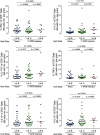Concurrent infection with Mycobacterium tuberculosis confers robust protection against secondary infection in macaques
- PMID: 30312351
- PMCID: PMC6200282
- DOI: 10.1371/journal.ppat.1007305
Concurrent infection with Mycobacterium tuberculosis confers robust protection against secondary infection in macaques
Abstract
For many pathogens, including most targets of effective vaccines, infection elicits an immune response that confers significant protection against reinfection. There has been significant debate as to whether natural Mycobacterium tuberculosis (Mtb) infection confers protection against reinfection. Here we experimentally assessed the protection conferred by concurrent Mtb infection in macaques, a robust experimental model of human tuberculosis (TB), using a combination of serial imaging and Mtb challenge strains differentiated by DNA identifiers. Strikingly, ongoing Mtb infection provided complete protection against establishment of secondary infection in over half of the macaques and allowed near sterilizing bacterial control for those in which a secondary infection was established. By contrast, boosted BCG vaccination reduced granuloma inflammation but had no impact on early granuloma bacterial burden. These findings are evidence of highly effective concomitant mycobacterial immunity in the lung, which may inform TB vaccine design and development.
Conflict of interest statement
The authors have declared that no competing interests exist.
Figures





References
-
- Andrews JR, Noubary F, Walensky RP, Cerda R, Losina E, Horsburgh CR. Risk of progression to active tuberculosis following reinfection with Mycobacterium tuberculosis. Clinical infectious diseases: an official publication of the Infectious Diseases Society of America. 2012;54(6):784–91. Epub 2012/01/24. 10.1093/cid/cir951 ; PubMed Central PMCID: PMC3284215. - DOI - PMC - PubMed
-
- Cohen T, van Helden PD, Wilson D, Colijn C, McLaughlin MM, Abubakar I, et al. Mixed-strain mycobacterium tuberculosis infections and the implications for tuberculosis treatment and control. Clin Microbiol Rev. 2012;25(4):708–19. Epub 2012/10/05. 10.1128/CMR.00021-12 ; PubMed Central PMCID: PMC3485752. - DOI - PMC - PubMed
-
- Charalambous S, Grant AD, Moloi V, Warren R, Day JH, van Helden P, et al. Contribution of reinfection to recurrent tuberculosis in South African gold miners. Int J Tuberc Lung Dis. 2008;12(8):942–8. Epub 2008/07/24. . - PubMed
Publication types
MeSH terms
Substances
Grants and funding
LinkOut - more resources
Full Text Sources
Medical

